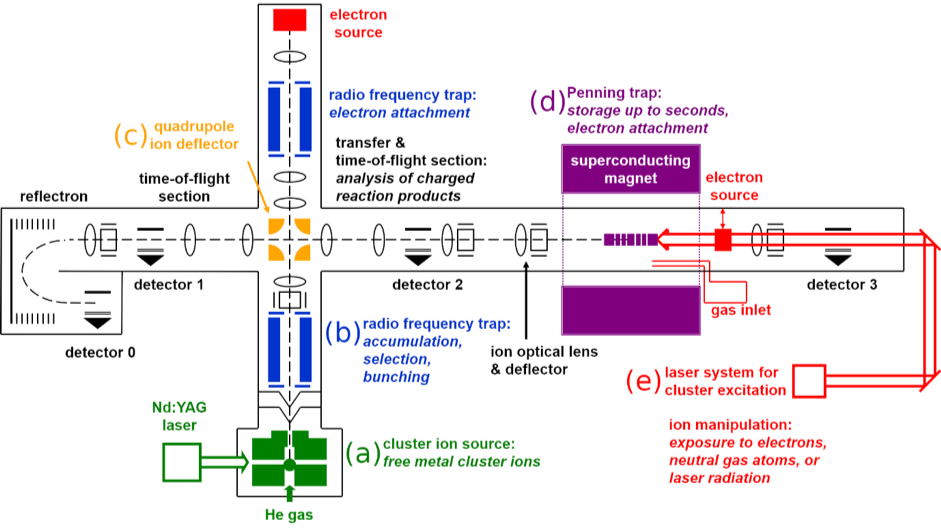ClusterTrap
The ClusterTrap magnet was shut down via controlled quench on 15. Nov. 2024.
ClusterTrap has been designed to investigate properties of atomic clusters in the gas phase with particular emphasis on the dependence on the cluster size and charge state. The combination of cluster source, ion traps and time-of-flight mass spectrometry allows a variety of experimental schemes including collision-induced dissociation, photo-dissociation, further ionization by electron impact, and electron attachment.
Positively or negatively singly-charged clusters are produced in a laser-ablation source (Figure 1 (a)) and accumulated in a radiofrequency ion trap (Figure 1 (b)). Then, the cluster ion bunch is transferred via a quadrupole ion deflector (Figure 1 (c)) into a Penning trap (Figure 1 (d)) and there prepared and subjected to one or several reaction steps (Figure 1 (e)). In the Penning trap, a superconducting magnet provides a homogenous magnetic field (Bz = 12 T), which confines the ions in the plane perpendicular to the magnetic field lines. For axial ion confinement, a voltage potential is applied to a stack of cylindrical electrodes (Figure 2), providing a harmonic trapping potential U(z). The center ring electrode is azimuthally split into 8 segments to allow for application of radial excitation fields (e.g. dipolar, quadrupolar and octupolar) and therefore manipulation of the amplitude of the radial ion motions in the trap (cyclotron motion and magnetron motion). The cylindrical geometry of the trap allows for easy axial access for different interaction methods with stored cluster ions (e.g. laser radiation, exposure to electron beams). Subsequently, the product ions are analyzed by time-of-flight (ToF) mass spectrometry.
Recent Publications:
Delayed photodissociation of the tin cluster Sn22-, A. Jankowski et al., Phys. Chem. Chem. Phys. 26, 1105 (2024) https://doi.org/10.1039/D3CP04476A
Production of polyanionic aluminium clusters with up to 10 excess electrons, S. Bandelow et al., Int. J. Mass Spectrom. 473, 116780 (2022) https://doi.org/10.1016/j.ijms.2021.116780
Photodissociation of mono- and di-anionic tin clusters, M. Wolfram et al., Eur. Phys. J. D 74, 135 (2020) https://link.aps.org/doi/10.1140/epjd/e2020-100614-2
Interaction of anionic tin clusters Snn-, n = 7-75 with electrons – polyanion production and cluster decay, S. König et al., Eur. Phys. J. D 72, 153 (2018) https://doi.org/10.1140/epjd/e2018-90158-y
Fission of polyanionic metal clusters, S. König et al., Phys. Rev. Lett. 120, 163001 (2018) https://doi.org/10.1103/PhysRevLett.120.163001
Disentangling the photodissociation pathways of small lead clusters by time-resolved monitoring of their delayed decays: The case of Pb31+, M. Wolfram et al., J. Phys. B 51, 044005 (2018) https://doi.org/10.1088/1361-6455/aa9801
Interaction of anionic lead clusters Pbn-, n=10, 12-102, with electrons - polyanion production and cluster decay, S. König et al., Int. J. Mass Spectrom. 421, 129-134 (2017) https://doi.org/10.1016/j.ijms.2017.06.009
Photodecay pathways of stored, size-selected lead clusters Pbn+, n = 6 – 41, and Pbn-, n = 9 – 56, S. König et al., J. Phys. Chem. C 121, 10858–10864 (2017) https://doi.org/10.1021/acs.jpcc.6b12074
Previous Highlights:
Two-electron emission after photoexcitation of metal-cluster dianions, A. Herlert and L. Schweikhard, New J. Phys. 14, 055015 (2012) http://dx.doi.org/10.1088/1367-2630/14/5/055015
Model-free Determination of Dissociation Energies of Polyatomic Systems, M. Vogel et al., Phys. Rev. Lett. 87 (1), 013401 (2001)https://doi.org/10.1103/PhysRevLett.87.013401
Multiply Charged Metal Cluster Anions, C. Yannouleas et al., Phys. Rev. Lett. 86 (14), 2996-2999 (2001)http://dx.doi.org/10.1103/PhysRevLett.86.2996
The Interaction of Gold Clusters with Methanol: Infrared Photodissociation of Mass-Selected Aun+(CH3OH)m, G. Dietrich et al., J. Chem. Phys. 112, 752-760 (2000)
Radiative Cooling of a Small Metal Cluster: The Case of V13+, C. Walther et al., Phys. Rev. Lett. 83, 3816-3819 (1999)
Multiple-Collision Induced Dissociation of Trapped Silver Clusters, Agn+ (2 n 25), S. Krückeberg et al., J. Chem. Phys. 110, 7216-7227 (1999)
Electronic Effects in the Production of Dianionic Gold Clusters by Electron Attachment onto Stored Aun-, L. Schweikhard et al., Philos. Mag. B 79, 1343-1352 (1999)
First Observation of Doubly Charged Negative Gold Cluster Ions, A. Herlert et al., Physica Scripta T80, 200-202 (1999)http://dx.doi.org/10.1238/Physica.Topical.080a00200
Time Resolved Photofragmentation of Stored Silver Clusters Ag n+ (n = 8 to 21), U. Hild et al., Phys. Rev., A 57, 2786-2793 (1998) https://doi.org/10.1103/PhysRevA.57.2786
Previous Reviews:
Upgrades at ClusterTrap and Latest Results, F. Martinez et al., Int. J. Mass Spectrom. 365-366, 266-274 (2014)
The new ClusterTrap setup, F. Martinez et al., Eur. Phys. J. D 63, 255-262 (2011) http://dx.doi.org/10.1140/epjd/e2011-10528-3
Atomic clusters in a Penning trap: Investigation of their properties and utilisation as diagnostic tools, N. Walsh et al., J. Phys. B 42, 154024 (2009) http://dx.doi.org/10.1088/0953-4075/42/15/154024
New Approaches to Stored Cluster Ions: The Determination of Dissociation Energies and Recent Results on Dianionic Metal Clusters, L. Schweikhard et al., Eur. Phys. J. D 24, 137-143 (2003) DOI 10.1140/epjd/e2003-00181-x
Metal Clusters as Investigated in a Penning Trap, L. Schweikhard et al., in E.E.B. Campbell and M. Larsson (eds.): "The Physics and Chemistry of Clusters", World Scientific, Singapore, 2001, pp. 267-277.
The Mainz Cluster Trap: Ion storage techniques at work in atomic cluster research, L. Schweikhard et al., Eur. Phys. J. D 9, 15-20 (1999) http://dx.doi.org/10.1007/s100530050391
Trapped Metal Cluster Ions, L. Schweikhard et al., Physica Scripta T59, 236-243 (1995)
A Penning Trap Mass Spectrometer for the Study of Cluster Ions, St. Becker et al., Rev. Sci. Instrum. 66, 4902-4910 (1995) DOI:10.1063/1.1146172
Early Penning-trap Investigations and Developments:
The Trapping Condition and a New Instability of the Ion Motion in the Ion Cyclotron Resonance Trap, L. Schweikhard et al., Int. J. Mass Spectrom. Ion Processes, 141, 77-90 (1995)
External Ion Accumulation in a Penning Trap with Quadrupole Excitation Assisted Buffer Gas Cooling, H.-U. Hasse et al., Int. J. Mass Spectrom. Ion Processes, 132, 181-191 (1994) doi:10.1016/0168-1176(93)03924-B

